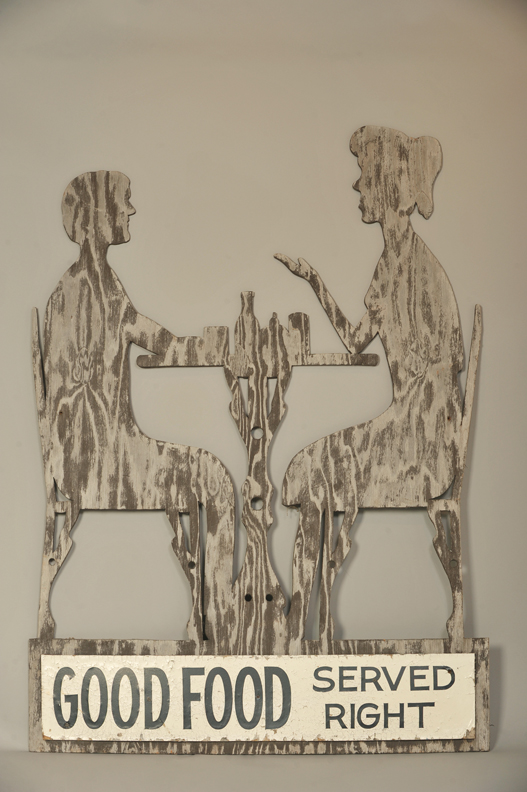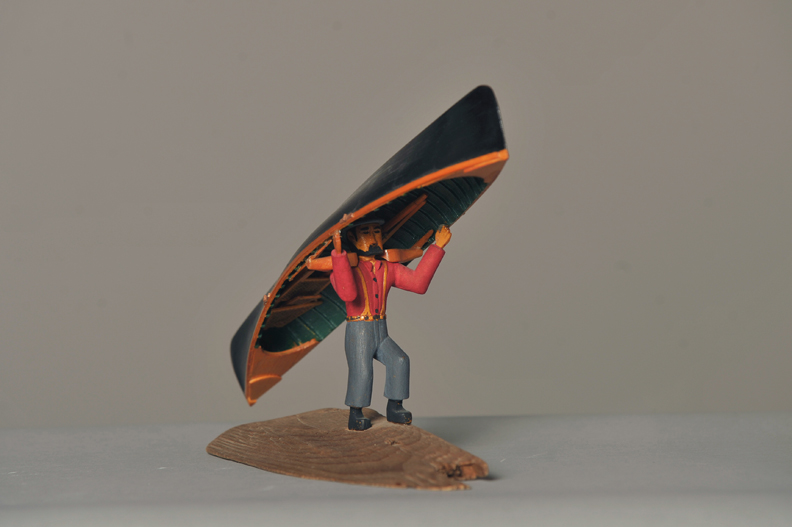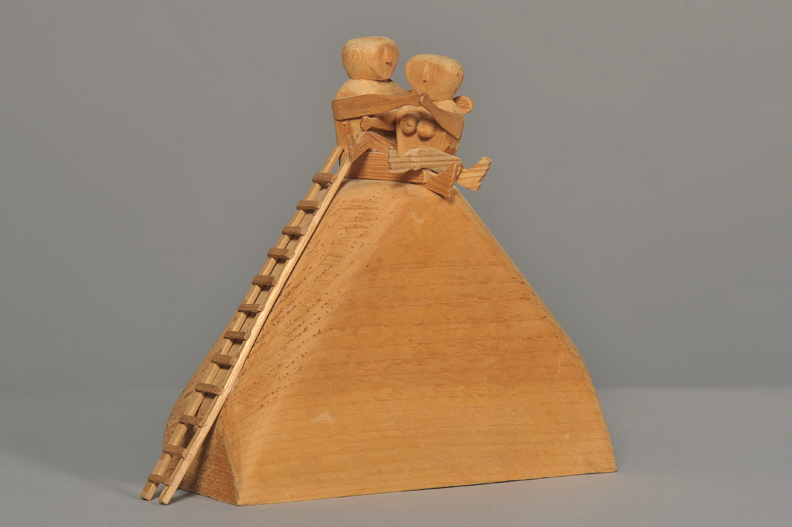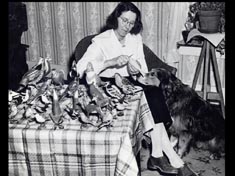Identity:
Keeping Connected
 For many folk artists, reinforcing a close identification with a group to which they belong is of great importance.
For many folk artists, reinforcing a close identification with a group to which they belong is of great importance.
They use forms, designs, colors, and motifs that clearly connect them and their work to others with a shared heritage or values. They may create objects for use by members of the group—as in rituals or customs—or to sustain insiders’ and outsiders' views of the group and its traditions.
Case Study
Hazel Tyrrell
Hazel Tyrrell (1894-1967) was known to her many friends as “The Pierrepont Birdwoman.” In the last 22 years of her life, she mastered the art of carving and painting native birds. She recalled creating between six and seven thousand birds, almost all of them of species to be found in backyards, woods, and fields, and along the rivers and lakes of the North Country.
After her husband Willie’s early death in 1932, Hazel continued farming with a few cows, sheep, and chickens and the help of her sister-in-law Dorothy. She was an avid outdoorswoman, as skilled with a deer rifle as she was with a scythe or an axe. Hazel began her interest in carving birds by watching another Pierrepont woman, Daisy Gleason, making lawn ornaments to sell. Working with only a few pocket knives and wood chisels, Hazel worked constantly to perfect her techniques, style, and repertoire.
By her own calculations, during her most productive years, she created between 300 and 500 birds per year. Examples — as varied as the common black-capped chickadee or goldfinch or the rare painted bunting or scarlet tanager — can be found today in collections near and far.
Hazel Tyrrell’s Wildlife Carvings
The following pieces by Hazel Tyrrell, all probably carved between 1955 and 1967, illustrate both the content and techniques of her artistry. The vireo and kinglet—small songbirds with carefully carved and painted bodies, twisted wire feet, and simple block mounts from a white birch limb—have all the characteristics of the vast majority of her prolific output. The woodpeckers and owl are likely from the latter part of her carving career, with their more elaborate mounts and sophisticated painting and carving. These may have been commissioned by any of the devoted customers who collected her work. The miniature deer mount and gun rack—made for a friend or family member—is unusual, possibly one of a kind. It illustrates one of the most common of North Country interior decorations, a trophy of successful hunting in the local woods.
White-Eyed Vireo
TAUNY Collection, Robert Consler Family Gift
Ruby-Crowned Kinglet
TAUNY Collection, Robert Consler Family Gift
Red-Headed Woodpecker
Courtesy of Allan P. Newell
Pileated Woodpecker
Courtesy of Allan P. Newell
Eastern Screech Owl
Courtesy of Allan P. Newell
White-Tailed Deer Mount, Rifle & Gun Rack
Courtesy of Fay & Barbara Van Brocklin
Masonic Blacksmith Sign
Perley Bogardus, Depeyster, 1925
Courtesy of private collection
This wrought iron sign was most likely made by Perley Bogardus for the exterior of his blacksmith shop in Depeyster to advertise horse shoeing, repairs, and hardware. Reported to weigh only 140 pounds, he practiced blacksmithing for local farmers well into the age of automobiles. He was also active for many years in the local Masonic lodge. The carpenter’s square and letter G have long been symbols of Free Masonry, used here as a proud statement of his identity and, perhaps, to entice fellow Masons to patronize his shop.
 Tin Man
Tin Man
Milford Howe, Canton, ca. 1940
Courtesy of Allan P. Newell
Workers in sheet metal—who make gutters, downspouts, and heating ducts—have also been known to be creative with their materials and skills. A common construction among them has been tin man figures, often to be used for advertising their trade. According to local stories, this piece from Milford Howe’s hardware store in Canton may have been made for the artist’s wife and never used in the store. With the funnel-shaped hat and the ax, it was likely made around or after 1939, when the movie The Wizard of Oz came out with the Tin Man character, which resembled this one.
Bracket Fungus Carving
Nellie Staves, Tupper Lake, ca. 2000
Courtesy of The Wild Center
 The art of carving images on freshly cut bracket or shelf fungus is truly an Adirondack custom. Nearly every old camp has at least a couple of them, probably made on rainy days for or by kids. From the time she was a child, Nellie Staves—an active trapper and outdoorswoman—collected “mushrooms” from dead or dying hardwood trees and etched beautiful pictures on them with simple tools—a protractor, a spoon, and a soft brush. She completed scores of them, usually with finely detailed images of wildlife, like this elaborate example.
The art of carving images on freshly cut bracket or shelf fungus is truly an Adirondack custom. Nearly every old camp has at least a couple of them, probably made on rainy days for or by kids. From the time she was a child, Nellie Staves—an active trapper and outdoorswoman—collected “mushrooms” from dead or dying hardwood trees and etched beautiful pictures on them with simple tools—a protractor, a spoon, and a soft brush. She completed scores of them, usually with finely detailed images of wildlife, like this elaborate example.
“Good Food Served Right” Diner Sign
Greg & Molly Caron, Hopkinton, ca. early 1980s
Courtesy of the artists
 This sign was created to hang outside Sara’s Kitchen, a small diner serving local customers, next to the Carons’ market and grocery in Hopkinton. Greg Caron says: “With money not being plentiful, we had to do with what we had. So, we took a flashlight and held it up with a roll of paper towels, casting the light to put our shadows on a 4 X 8 sheet of plywood, with first my wife and then me sitting at a diner table so we could trace a pattern. At the bottom we had many thoughts as to what it would say—Sara’s Kitchen, Home Town Diner, and many others. However, ‘Good Food Served Right’ was as simple as it could get and said it all.” The sign was later the logo and title for TAUNY’s prize-winning regional cookbook, published in 2000.
This sign was created to hang outside Sara’s Kitchen, a small diner serving local customers, next to the Carons’ market and grocery in Hopkinton. Greg Caron says: “With money not being plentiful, we had to do with what we had. So, we took a flashlight and held it up with a roll of paper towels, casting the light to put our shadows on a 4 X 8 sheet of plywood, with first my wife and then me sitting at a diner table so we could trace a pattern. At the bottom we had many thoughts as to what it would say—Sara’s Kitchen, Home Town Diner, and many others. However, ‘Good Food Served Right’ was as simple as it could get and said it all.” The sign was later the logo and title for TAUNY’s prize-winning regional cookbook, published in 2000.
 Adirondack Guideboat Model with Guide
Adirondack Guideboat Model with Guide
George Outcalt, Saranac Lake
Courtesy of Adirondack Museum
This painted model of an Adirondack guideboat and guide by George Outcalt was one of several he made. Guides and guideboats have been a major part of life in the mountans—a livelihood for locals and as recreation and relaxation for their clients. This is a scene so iconic of the region that it was adopted as the logo for the Adirondack Museum in Blue Mountain Lake.
 Boy and Girl in Haystack
Boy and Girl in Haystack
William Queor, North Lawrence, ca. 1970s
Courtesy of private collection
Often a theme in oral and written literature about American rural life, the boy and girl in a haystack represents some adventurous aspects of old-time courtship. William Queor grew up on small farms in the North Country and worked as a hired man in the lumber woods and on farms as an adult. This carving, with very simple lines and, as he preferred, unpainted surfaces, shows his untrained skill as a whittler and his quiet, tongue-in-cheek sense of humor.











